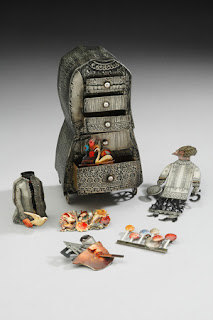Japanese-born metalsmith, Mariko Kusumoto, creates intimate metal environments that evoke the rich, sensual Japanese culture of her childhood. A brilliant technician, she masterfully fabricates and embellishes boxes using a variety of techniques including etching, electroforming, and patination. With astounding attention to detail she explores interior spaces, deftly transforming each compartment into interactive miniature theaters, revealing figures and objects with dozens of movable parts, rotating gears, and musical mechanisms.
She comments, “In my work, I am striving to create a world of shadows, light, silence, spirituality, and my personal memories. My father is a Buddhist priest, and I grew up in a temple that was founded four hundred years ago. While living in the temple, I took the place for granted and didn't think anything special of it. However, the more time that I spend living in the United States—with its diverse cultures and varied ethnic groups, the more conscious I become of my identity as a Japanese. As the yearning for my temple grows, I gain a greater sense of appreciation of it, as well as of Japanese culture in general. As time goes by, my memories become stronger and more vivid. This feeling is the inspiration of my artwork today.” Complex in their assembly, each of Kusumoto’s featured works are made up of nearly 100 individual pieces.
To see more of Mariko's work, visit our Galleries at 2100 Smallman Street in Pittsburgh's Strip District, or check it out on our website!





































